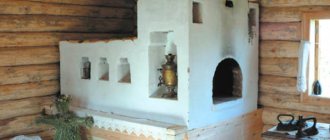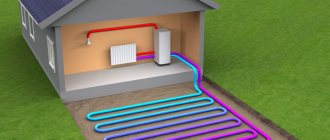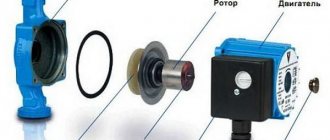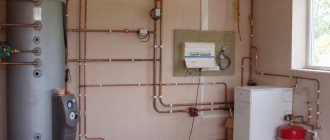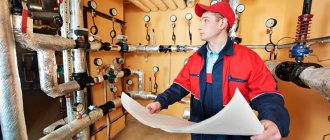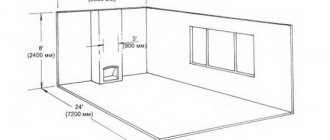Properly organizing home heating is not an easy task. It is clear that specialists - designers and installers - can handle it best. It is possible and necessary to involve them in the process, but in what capacity is up to you, the owner of the house, to determine. There are three options: hired people perform the entire range of activities or part of these works, or act as consultants, and you do the heating yourself.
Regardless of which heating option is chosen, you need to have a good understanding of all stages of the process. This material is a step-by-step guide to action. Its goal is to help you solve the heating installation problem yourself or competently supervise hired specialists and installers.
Heating system elements
In the vast majority of cases, private residential buildings are heated with water heating systems. This is a traditional approach to solving the issue, which has an undeniable advantage - universality. That is, heat is delivered to all rooms using a coolant, and it can be heated using various energy carriers. We will consider their list further when choosing a boiler.
Water systems also make it possible to organize combined heating using two or even three types of energy carriers.
Any heating system, where the coolant serves as the transfer link, is divided into the following components:
- heat source;
- pipeline network with all additional equipment and fittings;
- heating devices (radiators or heating circuits for underfloor heating).
For the purpose of processing and regulating the coolant, as well as performing maintenance work in heating systems, additional equipment and shut-off and control valves are used. The equipment includes the following items:
- expansion tank;
- circulation pump;
- hydraulic separator (hydraulic arrow);
- buffer capacity;
- distribution manifold;
- indirect heating boiler;
- devices and automation equipment.
Note. A mandatory attribute of a water heating system is an expansion tank; other equipment is installed as needed.
It is well known that when heated, water expands, and in a confined space there is nowhere for its additional volume to go. To avoid rupture of connections due to increased pressure in the network, an open or membrane type expansion tank is installed. She takes in excess water.
Forced circulation of the coolant is provided by a pump, and if there are several circuits separated by a hydraulic arrow or a buffer tank, 2 or more pumping units are used. As for the buffer tank, it works simultaneously as a hydraulic separator and a heat accumulator. Separating the boiler circulation circuit from all others is practiced in complex systems of cottages with several floors.
Collectors for coolant distribution are installed in heating systems with heated floors or in cases where a radial battery connection scheme is used, we will discuss this in the following sections. An indirect heating boiler is a tank with a coil where water for domestic hot water needs is heated from the coolant. To visually monitor the temperature and pressure of water in the system, thermometers and pressure gauges are installed. Automation tools (sensors, thermostats, controllers, servos) not only control the parameters of the coolant, but also regulate them automatically.
Schematic diagram of the heating system
An individual heating system for a country house consists of a boiler, a circulation pump, an expansion tank, heating radiators and pipes connecting all these elements. Water is used as a coolant if the heating system operates throughout the entire heating season (a country house for permanent residence), or antifreeze if the heating system is turned off for long periods during the heating season (a country house or a country house for periodic residence).
Fig.1.
Schematic diagram of an individual heating system for a country house.
The operating principle of an individual heating system is as follows. The boiler heats the coolant and, under the action of the circulation pump, the coolant moves through the pipes and heating devices. When heated, the coolant increases in volume, the expansion tank compensates for this, protecting the heating system from excess pressure and possible pipe ruptures.
Shut-off valves
In addition to the equipment listed, the water heating of the house is controlled and maintained using shut-off and control valves shown in the table:
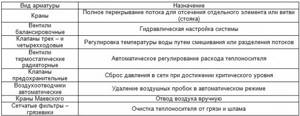
Once you have become familiar with what elements the heating system consists of, you can proceed to the first step towards the goal - calculations.
Calculation of the heating system and selection of boiler power
It is impossible to select equipment without knowing the amount of thermal energy required to heat the building. It can be determined in two ways: simple approximate and calculated. All sellers of heating equipment like to use the first method, since it is quite simple and gives a more or less correct result. This is a calculation of thermal power based on the area of heated premises.
They take a separate room, measure its area and multiply the resulting value by 100 W. The energy required for the entire country house is determined by summing up the indicators for all rooms. We suggest a more accurate method:
- by 100 W, multiply the area of those premises where only 1 wall, on which there is 1 window, is in contact with the street;
- if the room is a corner one with one window, then its area must be multiplied by 120 W;
- when a room has 2 external walls with 2 or more windows, its area is multiplied by 130 W.
If we consider power as an approximate method, then residents of the northern regions of the Russian Federation may not receive enough heat, and residents of the south of Ukraine may overpay for equipment that is too powerful. Using the second, calculation method, heating design is carried out by specialists. It is more accurate, as it gives a clear understanding of how much heat is lost through the building structures of any building.
Before you begin the calculations, you need to measure the house, finding out the area of the walls, windows and doors. Then you need to determine the thickness of the layer of each building material from which the walls, floors and roofs are built. For all materials in the reference literature or on the Internet, you should find the value of thermal conductivity λ, expressed in units of W/(m ºС). We substitute it into the formula for calculating the thermal resistance R (m2 ºС / W):
R = δ / λ, here δ is the thickness of the wall material in meters.
Note. When a wall or roof is made of different materials, it is necessary to calculate the R value for each layer and then sum the results.
Now you can find out the amount of heat lost through the external building structure using the formula:
- QTP = 1/R x (tв – tн) x S, where:
- QТП – lost amount of heat, W;
- S is the previously measured area of the building structure, m2;
- tв – here you need to substitute the value of the desired internal temperature, ºС;
- tн – street temperature in the coldest period, ºС.
Important! The calculation should be made for each room separately, alternately substituting into the formula the values of thermal resistance and area for the external wall, window, door, floors and roof. Then all these results must be summed up, this will be the heat loss of the given room. The area of internal partitions does not need to be taken into account!
DIY installation of heating systems in a private house video
Modern technologies make it possible to install a heating system for any private home with your own hands. There are several options, it all depends on the total area of the building and the preferred type of fuel. But it is recommended to entrust the calculation and design stage to a specialist, since without special experience it will not be possible to do everything exactly. It is also better to entrust the repair and maintenance of heating, ventilation and air conditioning systems (HVAC) to specialists.
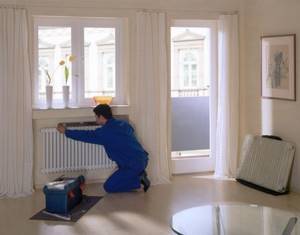
Types of heating systems for a private home You need to start by choosing a heating system, which can be: 1) Water with a closed circuit and a coolant in the form of hot water heated by a boiler. Water circulates from the boiler through the main pipes through all the radiators in the house, giving off heat and returning already cooled. Boilers can be electric, gas, solid and liquid fuel. The power depends on the total area, for example, for a house of 60-200 sq.m. A boiler up to 25 kW is suitable. 2) For a steam system, heated water vapor acts as a coolant. Such systems can be closed or open; they are complex; they are practically not used in private homes due to the danger and large dimensions of the boiler. 3) Air heating can only be used during the construction phase; this system is not suitable for a finished residential building. 4) Electric heating. This is a fairly common option, represented by underfloor heating systems, long-wave infrared converters and conventional floor/wall converters. The system is very easy to install, but it cannot be called economical, since the energy consumption can be very high.
Do-it-yourself installation You can order the installation of HVAC systems in Moscow from specialists, or do everything yourself. Before starting installation, it is necessary to determine which system will be used for heating. To do this, you should select a coolant whose use will be economically beneficial. For example, if there is a gas supply, it is best to install water heating with a main gas boiler and an auxiliary solid fuel or electric one for energy independence in case there is no gas supply. After this, it is necessary to draw up design documentation and calculations for the heating system, which the specialists of the design office will handle. It is better not to rely on chance and immediately entrust this stage to professionals, since the quality of the system and safety depend on the competence of the project and drawings. Based on the calculations carried out, materials and equipment are purchased.
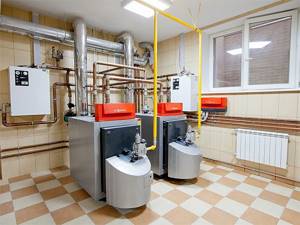
Heating boiler The first stage is the installation of the boiler, for which it is necessary to equip a separate room (except for electrical ones). It is best to do this in the basement, with excellent ventilation to remove combustion products, but you can set aside a small room on the ground floor with a small window for this. During installation, the boiler is placed in such a way that it remains freely accessible. It is recommended to cover the walls with fire-resistant materials. A chimney pipe is laid from the boiler through the wall to the street.
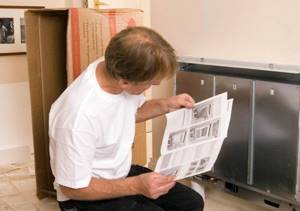
Manifold cabinet and pipe laying The next step is the installation of a circulation pump, a hydraulic accumulator (if the diagram requires their use), connection of the manifold, control and measuring instruments, which should be located near the boiler. The collector is selected according to the number of outgoing pipes; it is placed near the outlet and the pump. Heating lines are laid in accordance with the selected diagram to the radiators, which will require making holes through the walls. Radiators are installed only after the installation of heating pipes is completed.
Installation of heating devices Radiators may not be located in all rooms; this should definitely be considered at the design stage. They can only be placed under the window opening (installation on the sides is not allowed!). From the floor to the bottom of the equipment there should be at least 10-12 cm, from the window sill to the top point - 10 cm, from the surface of the walls - 2-5 cm (special brackets are used). Control and shut-off valves and temperature sensors are installed at the outlet/input.
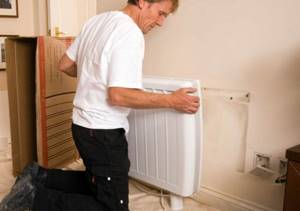
After all elements of the heating system are installed, pressure testing and the first test run are performed, for which representatives of the gas service should be invited (if a gas boiler is used). To start an electric or solid fuel boiler, the presence of service specialists is not required. Installing an individual heating system for a private home is a complex and responsible matter. Despite the fact that individual elements and components can be installed with your own hands, the design and drawings should be drawn up by specialists; this will save you from many problems in the future. In addition, the availability and economical fuel consumption of the system should be taken into account.
WE RECOMMEND READING
- 07/19/2016 ROMMER heating radiators and their advantages
- 02/14/2015Jute insulation
- 04/10/2016Insulation of wooden houses
- 02.02.2017Infrared heating at home
Heat consumption for ventilation
To find out how much heat a private house loses as a whole, you need to add up the losses of all its rooms. But that’s not all, because we must also take into account the heating of the ventilation air, which is also provided by the heating system. In order not to go into the jungle of complex calculations, it is proposed to find out this heat consumption using a simple formula:
Qair = cm (tв – tн), where:
- Qair – required amount of heat for ventilation, W;
- m – amount of air by mass, defined as the internal volume of the building multiplied by the density of the air mixture, kg;
- (tв – tн) – as in the previous formula;
- с – heat capacity of air masses, is taken equal to 0.28 W / (kg ºС).
To determine the heat demand for the entire building, it remains to add the value of QTP for the house as a whole with the value of Qair. The boiler power is taken with a reserve for the optimal operating mode, that is, with a coefficient of 1.3. Here you need to take into account an important point: if you plan to use a heat generator not only for heating, but also for heating water for domestic hot water supply, then the power reserve must be increased. The boiler must operate effectively in 2 directions at once, and therefore the safety factor must be taken at least 1.5.
Recommendations for choosing a boiler
At the moment, there are various types of heating, characterized by the energy carrier or type of fuel used. Which one to choose is up to you, and we will present all types of boilers with a brief description of their pros and cons. To heat residential buildings, you can purchase the following types of household heat generators:
- solid fuel;
- gas;
- electrical;
- on liquid fuel.
The following video will help you choose an energy carrier, and then a heat source:
Hot water supply and heating diagram
Combining the two systems becomes more expedient, because the second circuit is present in many modern heaters:
- DHW allows the use of almost all types of boilers . Power is calculated based on the area of the house. If it has from 60 to 300 square meters. then it is quite enough to use 25-35 kW, and from 300 to 1200 - 35-100 kW. The closed cycle allows the use of both water and antifreeze. Well suited for flow-through heaters that are mounted on the wall and floor.
- The indirect exchange storage boiler is quite popular, since the electric heater installed in the lower part can be turned on as needed. In modern models, a flow-through heater is installed in the boiler instead of a heat exchanger. The water heats up very quickly as the pump delivers it to the top. A double-circuit layer-by-layer heating boiler will cost less, it is more compact and will require less time for installation.
- For hot water supply, you can install a storage gas heater. This is especially advisable in houses where a boiler running on solid or liquid fuel was installed, since it is better to use it for heating.
- To ensure constant circulation of water throughout the house from a storage water heater, a low-power circulation pump . Hot water will flow simultaneously to the kitchen and bathroom, and the temperature and pressure will be approximately the same.
- For heating it is better to use a two-pipe system. Constant circulation of water will provide warmth. Each radiator must be equipped with a tap so that it can be turned off.
- The collector system is more complex, as it involves connecting each radiator and will require installing a large number of pipes and a collector cabinet. The advantage is that it will be possible to regulate the temperature in any room and it will be easier to do repairs , since you will not have to turn off the heating in the entire house.
Solid fuel boilers
Solid fuel boilers are divided into 3 types: direct combustion, pyrolysis and pellet. The units are popular due to their low operating costs, because compared to other energy sources, firewood and coal are inexpensive. The exception is natural gas in the Russian Federation, but connecting to it is often more expensive than all the heating equipment including installation. Therefore, wood and coal boilers, which have an acceptable cost, are being purchased by people more and more often.
On the other hand, operating a solid fuel heat source is very similar to simple stove heating. You need to spend time and effort to prepare, carry firewood and load it into the firebox. The unit also requires serious piping to ensure its long-lasting and safe operation. After all, a conventional solid fuel boiler is characterized by inertia, that is, after closing the air damper, the heating of water does not stop immediately. And efficient use of generated energy is possible only if there is a heat accumulator.
Important. Boilers that burn solid fuels generally cannot boast of high efficiency. Traditional direct combustion units have an efficiency of about 75%, pyrolysis units - 80%, and pellet units - no more than 83%.
The best choice in terms of comfort is a pellet heat generator, characterized by a high level of automation and virtually no inertia. It does not require a heat accumulator and frequent trips to the boiler room. But the price of equipment and pellets often makes it inaccessible to a wide range of users.
Wiring of a solid fuel heating boiler, diagram
All heat generators operate on this principle.
They receive the energy necessary for work from various solid fuels. It should be noted that they have some operational features that must be taken into account when connecting such boilers to the heating system. It should be noted that the piping diagram of a solid fuel boiler includes several elements and devices that must be used. so that the heating system operates for a long time.
The wiring diagram for a solid fuel boiler is the necessary devices and elements that together form a single heating system. This heating system includes:
- Boiler.
- Circulation pump.
- Expansion tank.
- Emergency power system.
- Co-mixing system.
- Buffer capacity.
- Emergency circuit
- Corrosion protection system.
- Pressure gauge, drain cock, special valve. It's all collected in one block
- Thermal valve.
- Float valve.
Gas boilers
An excellent option is to install heating that operates on main gas. In general, hot water gas boilers are very reliable and efficient. The efficiency of the simplest energy-independent unit is at least 87%, and the efficiency of an expensive condensing unit is up to 97%. The heaters are compact, well automated and safe to operate. Maintenance is required no more than once a year, and trips to the boiler room are needed only to monitor or change settings. A budget unit will be much cheaper than a solid fuel unit, so gas boilers can be considered generally available.
Just like solid fuel heat generators, gas boilers require a chimney and supply and exhaust ventilation. As for other countries of the former USSR, the cost of fuel there is much higher than in the Russian Federation, which is why the popularity of gas equipment is steadily declining.
Electric boilers
It must be said that electric heating is the most efficient of all existing ones. Not only are the efficiency of boilers about 99%, but in addition they do not require chimneys or ventilation. There is practically no maintenance of the units as such, except for cleaning once every 2-3 years. And most importantly: equipment and installation are very cheap, and the degree of automation can be any. The boiler simply does not need your attention.
No matter how pleasant the advantages of an electric boiler are, the main disadvantage is just as significant - the price of electricity. Even if you use a multi-tariff electricity meter, you will not be able to beat a wood-burning heat generator in terms of this indicator. This is the price to pay for comfort, reliability and high efficiency. Well, the second disadvantage is the lack of the necessary electrical power on the supply networks. Such an annoying nuisance can immediately cancel out all thoughts about electric heating.
Liquid fuel boilers
In terms of the cost of heating equipment and its installation, heating with waste oil or diesel fuel will cost approximately the same as with natural gas. Their efficiency indicators are also similar, although the processing, for obvious reasons, is somewhat inferior. Another thing is that this type of heating can easily be called the dirtiest. Any visit to the boiler room will end with at least the smell of diesel fuel or dirty hands. And the annual cleaning of the unit is a whole event, after which you will be smeared with soot up to your waist.
Using diesel fuel for heating is not the most profitable solution; the price of fuel can hit your pocket hard. Used oil has also risen in price, unless you have some cheap source. This means that it makes sense to install a diesel boiler when there are no other energy sources or, in the future, a main gas supply. The unit easily switches from diesel fuel to gas, but the exhaust furnace will not be able to burn methane.
Heating system diagrams for a private home
Heating systems sold in private housing construction can be single-pipe or double-pipe. It's easy to distinguish them:
- according to a single-pipe scheme, all radiators are connected to one collector. It is both a supply and a return, passing by all the batteries in the form of a closed ring;
- in a two-pipe scheme, the coolant is supplied to the radiators through one pipe and returned through the other.
Choosing a heating system layout for a private home is not an easy task; consultation with a specialist will certainly not hurt. We will not sin against the truth if we say that the two-pipe scheme is more progressive and reliable than the one-pipe one. Contrary to popular belief about the low installation costs when installing the latter, we note that it is not only more expensive than a two-pipe one, but also more complex. This topic is covered in great detail in the video:
The fact is that in a single-pipe system, the water from radiator to radiator cools more and more, so it is necessary to increase their capacity by adding sections. In addition, the distribution manifold must have a larger diameter than the two-pipe distribution lines. And lastly: automatic control with a single-pipe circuit is difficult due to the mutual influence of the batteries on each other.
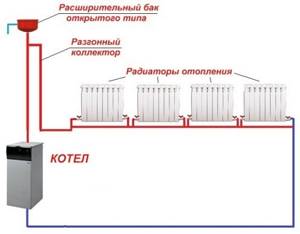
In a small house or dacha with up to 5 radiators, you can safely implement a single-pipe horizontal circuit (common name - Leningradka). With a larger number of heating devices, it will not be able to function normally, because the last radiators will be cold.
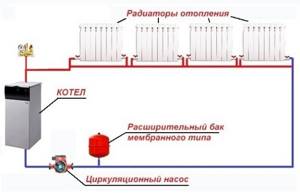
Another option is to use single-pipe vertical risers in a two-story private house. Such schemes occur quite often and work successfully.
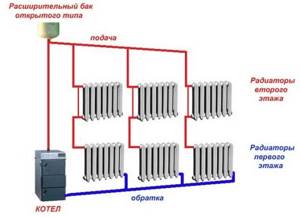
With a two-pipe distribution, the coolant is delivered to all radiators at the same temperature, so there is no need to increase the number of sections. Dividing the lines into supply and return makes it possible to automatically control the operation of the batteries using thermostatic valves.
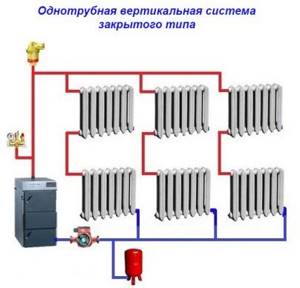
The diameters of the pipelines are smaller, and the system as a whole is simpler. There are the following types of two-pipe schemes:
dead-end: the pipeline network is divided into branches (arms), through which the coolant moves along the highways towards each other;
associated two-pipe system: here the return manifold is, as it were, a continuation of the supply, and the entire coolant flows in one direction, the circuit forms a ring;
collector (radial). The most expensive wiring method: pipelines from the collector are laid separately to each radiator, the installation method is hidden, in the floor.
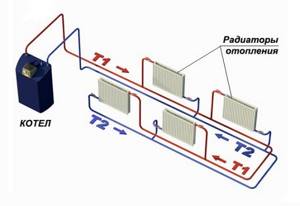
If you take horizontal lines of larger diameter and lay them with a slope of 3-5 mm per 1 m, then the system will be able to work due to gravity (by gravity). Then a circulation pump is not needed, the circuit will be non-volatile. To be fair, we note that both single-pipe and two-pipe wiring can function without a pump. If only conditions were created for natural water circulation.
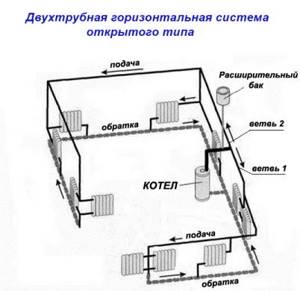
The heating system can be made open by installing an expansion tank at the highest point, communicating with the atmosphere. This solution is used in gravity networks, otherwise it cannot be done there. If you install a membrane-type expansion tank on the return line near the boiler, the system will be closed and operate under excess pressure. This is a more modern option, which finds its application in networks with forced movement of coolant.
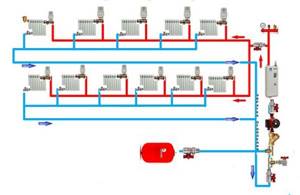
It is impossible not to mention the method of heating a house with warm floors. Its disadvantage is that it is expensive, since you will need to lay hundreds of meters of pipes in a screed, resulting in a heating water circuit in each room. The ends of the pipes converge to a distribution manifold with a mixing unit and its own circulation pump. An important advantage is the economical, uniform heating of rooms, which is very comfortable for people. Underfloor heating circuits are clearly recommended for use in any residential buildings.

Advice. The owner of a small house (up to 150 m2) can safely recommend adopting a conventional two-pipe circuit with forced circulation of coolant. Then the diameters of the mains will be no more than 25 mm, the branches - 20 mm, and the connections to the batteries - 15 mm.
Heating system pipe routing
The most popular are 2 schemes: one-pipe and two-pipe. Let's look at what they are.
A single-pipe system is the most basic option, however, not the most effective. It is a closed circle of pipes, shut-off valves, and automation, the center of which is the boiler. A pipe runs from it along the lower plinth to all rooms, connecting to all radiators and other heating devices.
Plus diagrams. ease of installation, small amount of material for constructing the circuit.
Minus. uneven distribution of coolant across radiators. The radiators in the outer rooms will warm up worse, since they are the last ones in the path of water movement. However, this problem can be solved by installing a pump or increasing the number of sections in the latest radiators.
A two-pipe system is a more effective method, since it solves the problem of uniform distribution of water throughout all heating devices. The pipes can be placed at the top (this option is preferable, because then the water can circulate naturally) or at the bottom (then a pump will be required).
Heating system installation
We will begin the description of installation work with the installation and piping of the boiler. In accordance with the rules, units whose power does not exceed 60 kW can be installed in the kitchen. More powerful heat generators should be located in the boiler room. At the same time, for heat sources that burn different types of fuel and have an open combustion chamber, it is necessary to ensure a good air flow. A chimney device is also required to remove combustion products.
For natural water movement, it is recommended to install the boiler in such a way that its return pipe is below the level of the ground floor radiators.
The location where the heat generator will be located must be selected taking into account the minimum permissible distances to walls or other equipment. Typically these intervals are specified in the manual supplied with the product. If this data is not available, then we adhere to the following rules:
- passage width on the front side of the boiler is 1 m;
- if there is no need to service the unit from the side or rear, then leave a gap of 0.7 m, otherwise - 1.5 m;
- distance to the nearest equipment – 0.7 m;
- when placing two boilers next to each other, a passage of 1 m is maintained between them, and opposite each other - 2 m.
Note. When installing wall-mounted heat sources, side passages are not needed; you only need to maintain clearance in front of the unit for ease of maintenance.
Pipes for heating system
In an individual heating system for a country house, the coolant temperature does not exceed 90 degrees, so all types of pipes can be used. However, polypropylene pipes are most often preferred. That's why:
- Polypropylene pipes are reliable, durable and not subject to corrosion and contamination.
- The cost of fittings is not high compared to metal-plastic pipes, and when installing a heating system, a lot of fittings will be required.
- All connections of polypropylene pipes are made by welding, which ensures high reliability and no need to periodically check the connections. Therefore, they can be safely placed in the wall or under the floor.
- Welding polypropylene pipes is simple and anyone can master it. The cost of the welding machine is low.
The procedure for welding polypropylene pipes is as follows:
- The welding machine heats up to 260-270 degrees.
- The pipe and fitting are simultaneously placed on the corresponding nozzles.
- Exposure time is 5-7 seconds. This time is necessary to melt the surface layer of the pipe and fitting.
- Connect the pipe and fitting. The welding layer is approximately 10 mm.
- After cooling for 30 - 60 seconds, the connection is ready for use.
When wiring a heating system around the house, a pipe with a diameter of 25-32 mm is usually used, and a pipe with a diameter of 20 mm is used to connect heating radiators.

Fig.5.
Connecting a heating radiator in a two-pipe circuit.
For heating systems, it is advisable to use a special reinforced pipe. Such pipes practically do not change their dimensions when heated, and, therefore, a large number of compensation bends are not required.
Boiler connection
It should be noted that the wiring of gas, diesel and electric heat generators is almost the same. Here we must take into account that the vast majority of wall-mounted boilers are equipped with a built-in circulation pump, and many models are equipped with an expansion tank. First, let's look at the connection diagram for a simple gas or diesel unit:
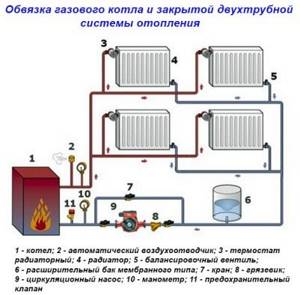
The figure shows a diagram of a closed system with a membrane expansion tank and forced circulation. This tying method is the most common. The pump with a bypass line and a sump tank is located on the return line, and there is also an expansion tank there. The pressure is controlled using pressure gauges, and air is removed from the boiler circuit through an automatic air vent.
Note. Piping an electric boiler that is not equipped with a pump is carried out according to the same principle.
When the heat generator is equipped with its own pump, as well as a circuit for heating water for domestic hot water needs, the pipe layout and installation of elements is as follows:
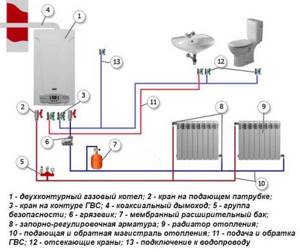
Shown here is a wall-mounted boiler with forced air injection into a closed combustion chamber. To remove flue gases, a double-walled coaxial flue is used, which is led out horizontally through the wall. If the firebox of the unit is open, then you need a traditional chimney with good natural draft. How to properly install a chimney pipe made of sandwich modules is shown in the figure:

In country houses with a large area, it is often necessary to connect a boiler with several heating circuits - a radiator, heated floors and an indirect heating boiler for DHW needs. In such a situation, the optimal solution would be to use a hydraulic separator. It will allow you to organize independent circulation of coolant in the boiler circuit and at the same time serve as a distribution comb for the remaining branches. Then the basic heating diagram for a two-story house will look like this:

According to this scheme, each heating circuit has its own pump, thanks to which it operates independently of the others. Since coolant with a temperature of no more than 45 ° C should be supplied to heated floors, three-way valves are used on these branches. They add hot water from the main line when the temperature of the coolant in the heated floor circuits drops.
With solid fuel heat generators the situation is more complicated. Their strapping should take into account 2 points:
- possible overheating due to the inertia of the unit; the firewood cannot be extinguished quickly;
- formation of condensation when cold water enters the boiler tank from the network.
To avoid overheating and possible boiling, the circulation pump is always placed on the return side, and on the supply side there should be a safety group located immediately behind the heat generator. It consists of three elements: a pressure gauge, an automatic air vent and a safety valve. The presence of the latter is crucial; it is the valve that will relieve excess pressure when the coolant overheats. If you decide to heat your house with wood, then the following wiring diagram is required:
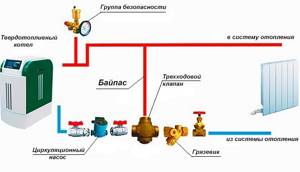
Here, a bypass and a three-way valve protect the furnace of the unit from condensation. The valve will not allow water from the system into the small circuit until the temperature in it reaches 55 °C. Detailed information on this issue can be obtained by watching the video:
Advice. Due to the nature of their operation, solid fuel boilers are recommended to be used in conjunction with a buffer tank - a heat accumulator, as shown in the diagram:

Many homeowners install two different heat sources in the furnace room. They must be properly tied and connected to the system. For this case, we offer 2 schemes, one of them is for a solid fuel and an electric boiler working together with radiator heating.
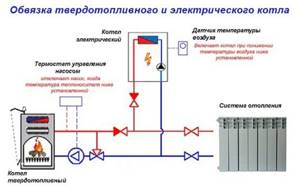
The second scheme combines a gas and wood heat generator, supplying heat to heat the house and prepare water for hot water supply:
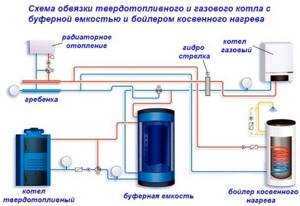
How to connect a solid fuel boiler
The canonical connection diagram for a solid fuel boiler contains two main elements that allow it to function reliably in the heating system of a private home. This is a safety group and a mixing unit based on a three-way valve with a thermal head and a temperature sensor, shown in the figure:
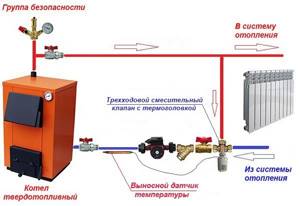
Note. The expansion tank is not shown here, since it can be located in different places in different heating systems.
The presented diagram shows how to connect the unit correctly and should always accompany any solid fuel boiler, preferably even a pellet one. You can find various general heating schemes anywhere - with a heat accumulator, an indirect heating boiler or a hydraulic arrow, on which this unit is not shown, but it must be there. This is explained in more detail in the video:
The task of the safety group, installed directly at the outlet of the supply pipe of a solid fuel boiler, is to automatically relieve pressure in the network when it rises above a set value (usually 3 Bar). This is done by a safety valve, and in addition to it, the element is equipped with an automatic air vent and a pressure gauge. The first releases the air appearing in the coolant, the second serves to control the pressure.
Attention! It is not allowed to install any shut-off valves on the section of the pipeline between the safety group and the boiler
How the scheme works
The mixing unit, which protects the heat generator from condensation and temperature changes, operates according to the following algorithm, starting from kindling:
- The firewood is just starting to burn, the pump is on, the valve on the side of the heating system is closed. The coolant circulates in a small circle through the bypass.
- When the temperature in the return pipeline rises to 50-55 °C, where the attached remote-type sensor is located, the thermal head, at its command, begins to press the three-way valve stem.
- The valve slowly opens and cold water gradually enters the boiler, mixing with hot water from the bypass.
- As all the radiators warm up, the overall temperature increases and then the valve closes the bypass completely, passing all the coolant through the heat exchanger of the unit.
This piping scheme is the simplest and most reliable; you can easily install it yourself and thus ensure the safe operation of the solid fuel boiler. There are a couple of recommendations regarding this, especially when piping a wood-burning heater in a private house with polypropylene or other polymer pipes:
- Make the section of the pipe from the boiler to the safety group from metal, and then lay plastic.
- Thick-walled polypropylene conducts heat poorly, which is why the surface-mounted sensor will openly lie, and the three-way valve will lag. For correct operation of the unit, the area between the pump and the heat generator, where the copper flask is located, must also be metal.
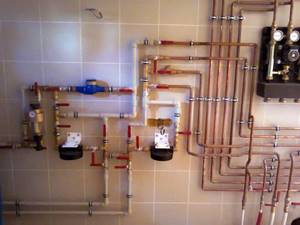
Another point is the installation location of the circulation pump. It is best for him to stand where he is shown in the diagram - on the return line in front of the wood-burning boiler. In general, you can install the pump on the supply side, but remember what was said above: in an emergency, steam may appear in the supply pipe. The pump cannot pump gases, so if steam gets into it, the circulation of the coolant will stop. This will speed up a possible explosion of the boiler, because it will not be cooled by water flowing from the return.
Way to reduce the cost of strapping
The condensate protection circuit can be reduced in cost by installing a three-way mixing valve of a simplified design that does not require connecting an overhead temperature sensor and thermal head. It already has a thermostatic element installed, set to a fixed mixture temperature of 55 or 60 °C, as shown in the figure:
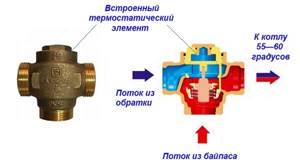
Special 3-way valve for solid fuel heating units HERZ-Teplomix
Note. Similar valves, which maintain a fixed temperature of mixed water at the outlet and are intended for installation in the primary circuit of a solid fuel boiler, are produced by many well-known brands - Herz Armaturen, Danfoss, Regulus and others.
Installing such an element definitely allows you to save on piping the TT boiler. But in this case, the possibility of changing the temperature of the coolant using a thermal head is lost, and its deviation at the output can reach 1-2 °C. In most cases, these shortcomings are insignificant.
Recommendations for the selection and installation of pipes
To install the heating of a private house with your own hands, you first need to decide which pipes to choose for this. The modern market offers several types of metal and polymer pipes suitable for heating private homes:
- steel;
- copper;
- stainless steel;
- polypropylene (PPR);
- polyethylene (PEX, PE-RT);
- metal-plastic.
Heating lines made of ordinary “ferrous” metal are considered a relic of the past, since they are most susceptible to corrosion and “overgrowth” of the flow area. In addition, it is not easy to independently install such pipes: you need good welding skills to make a hermetically sealed joint. However, some homeowners still use steel pipes to this day when they install autonomous heating at home.
Copper or stainless steel pipes are an excellent choice, but they are too expensive. These are reliable and durable materials that are not afraid of high pressure and temperature, so if you have the means, these products are definitely recommended for use. Copper is joined by soldering, which also requires some skills, and stainless steel is joined using dismountable or press fittings. Preference should be given to the latter, especially when the installation is hidden.
Advice. For piping boilers and laying pipelines within the boiler room, it is best to use any type of metal pipes.
Heating made from polypropylene will cost you the cheapest. Of all types of PPR pipes, you need to choose those that are reinforced with aluminum foil or fiberglass. The low price of the material is their only advantage, since installing heating from polypropylene pipes is quite a complex and responsible task. And in appearance, polypropylene is inferior to other plastic products.
The joints of PPR pipelines with fittings are made by soldering, and it is not possible to check their quality. When the heating was insufficient during soldering, the connection will certainly leak later, but if it is overheated, the melted polymer will half block the flow area. Moreover, you won’t be able to see this during assembly; flaws will make themselves known later, during operation. The second significant drawback is the large elongation of the material during heating. To avoid “saber” bends, the pipe must be mounted on movable supports, and a gap must be left between the ends of the line and the wall.
Recommendation. Do not embed polypropylene products into floor screeds or wall strobes. This is especially true for pipe joints.
It is much easier to make your own heating from polyethylene or metal-plastic pipes. Although the price of these materials is higher than polypropylene. For a beginner, they are the most convenient, since the joints here are made quite simply. Pipelines can be laid in a screed or wall, but with one condition: connections must be made using press fittings, not collapsible ones.
Metal-plastic and polyethylene are used both for open laying of highways and hidden behind any screens, as well as for the installation of water-heated floors. The disadvantage of PEX pipes is that it tends to return to its original state, which can cause the installed heating manifold to appear slightly wavy. PE-RT polyethylene and metal-plastic do not have such a “memory” and easily bend as you need. More information about choosing pipes is described in the video:
Selecting a heating system scheme
Heating system diagrams are methods for laying heating pipes and connecting heating radiators to them. The configuration (balancing) of the heating system, flow rate and laying of heating pipes depend on the type of heating system diagram.
There are three basic diagrams of the heating system: one-pipe (Leningradka), two-pipe and radiant.

Fig.2.

Fig.3.

Fig.4.
A single-pipe heating system diagram (Fig. 2.) represents one pipe to which heating radiators are connected. The pipe is laid around the perimeter of the house and connected to the heating boiler. In this scheme, the pipe flow is minimal. The disadvantage is that each subsequent heating radiator will heat worse than the previous one, and it is very difficult to evenly redistribute heat between them.
A two-pipe heating system (Fig. 3.) is a system of two pipes, one supply and the other return. Heating radiators are connected to the supply and return. It turns out that the radiators are connected in parallel and the heat is distributed evenly across them. This scheme is easy to adjust, so it is used most often.
The radial circuit (Fig. 4.) differs from the two-pipe circuit in that the heating radiators are independently connected. Distribution manifolds are used for this purpose. In this case, it becomes possible to individually configure each heating device, which has a positive effect on heating savings. According to this scheme, a water heated floor is connected. The disadvantage is the high consumption of heating pipes.
Recommendations for choosing and connecting radiators
An ordinary homeowner, going to a heating equipment store and seeing a wide selection of different radiators there, can conclude that choosing batteries for his home is not so easy. But this is the first impression; in fact, there are not so many varieties of them:
- aluminum;
- bimetallic;
- steel panel and tubular;
- cast iron
Note. There are also designer water heating devices of a wide variety of types, but they are expensive and deserve a separate detailed description.
Sectional batteries made of aluminum alloy have the best heat transfer rates; bimetallic heaters are not far behind them. The difference between the two is that the former are made entirely of alloy, while the latter have a tubular steel frame inside. This was done for the purpose of using the devices in centralized heat supply systems of high-rise buildings, where the pressure can be quite high. Therefore, installing bimetallic radiators in a private cottage makes no sense at all.
It should be noted that heating installation in a private home will be cheaper if you purchase steel panel radiators. Yes, their heat transfer rates are lower than those of aluminum ones, but in practice you are unlikely to feel the difference. As for reliability and durability, the devices will successfully serve you for at least 20 years, or even more. In turn, tubular batteries are much more expensive, in this respect they are closer to designer ones.
Steel and aluminum heating devices have one useful quality in common: they lend themselves well to automatic control using thermostatic valves. The same cannot be said about massive cast iron batteries, on which it is pointless to install such valves. This is due to the ability of cast iron to heat up for a long time and then retain heat for some time. Also because of this, the rate of heating of the premises is reduced.
If we touch on the issue of appearance aesthetics, then the cast-iron retro radiators currently offered are much more beautiful than any other batteries. But they also cost incredible amounts of money, and inexpensive Soviet-style accordions MS-140 are only suitable for a one-story country house. From the above, the conclusion suggests itself:
For a private home, buy those heating devices that you like best and are comfortable with in terms of cost. Just take into account their features and choose the right size and thermal power.
What type of heating to choose
Naturally, the starting point for planning a heating scheme is the selection and purchase of a boiler.
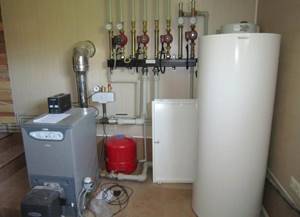
Heating boilers
Now we will not consider non-standard devices that can run on wood or any solid fuel, diesel fuel or waste oil, etc. Because, as a rule, using them to organize hot water supply and heating at the same time is difficult and expensive.
Advice: if your area does not have gas supply, and there are frequent interruptions in electricity, then perhaps you should still consider the option of installing boilers that also run on alternative fuel as a heating source. Otherwise, there is a big risk that in winter, from time to time, the house will be left without heat.
As illustrative examples, let’s take a closer look at the more familiar systems that run on gas or electricity. We will also consider how to best organize the supply of hot water based on such boilers.
So, an overview of the two “classic” types of boilers.
Gas boilers
These devices can be divided into several of the most common types.
- AOGV. Floor-standing boilers with an expansion tank are designed for completely autonomous operation. Most often, it is impossible to heat water for domestic needs with their help. The obvious advantage of the AOGV is, naturally, its autonomy, since the operation of the device does not require the supply of electricity to the automation.
The disadvantages include not very economical gas consumption and not very good build quality and automation in inexpensive models.

AOGV
- Wall-mounted chimney boilers with electronic control. As a rule, these are very economical and efficient devices with a high level of efficiency. Water enters the radiators using either an external or built-in pump.
But this is both a plus and a minus - because in most cases such boilers cannot operate without electricity. Hot water for the bath, shower and kitchen is supplied through a second circuit.
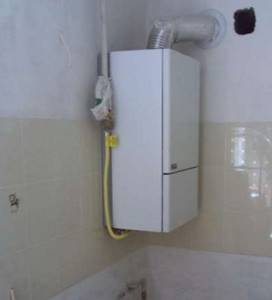
Chimney boiler
- Wall-mounted turbocharged boilers. Also an excellent option with a high level of efficiency, and thanks to the turbine, such boilers can be installed almost anywhere in the room, since there is no connection to the chimney. The disadvantage is the same as in the previous case - in the absence of electricity, the automation and the turbine itself do not work.

Turbocharged boiler
Advice: if you want to purchase an energy-dependent, but very economical gas boiler and there are usually no power outages, still play it safe - purchase at least such an additional accessory as an uninterruptible power supply for gas boilers. Essentially, this is a battery that will keep the automation operating while there is no electricity in the house.

Uninterruptable power source
We looked at gas boilers as a heating source, but what about hot water in this case?
Well, everything is simple in principle - either a double-circuit boiler or an additional gas water heater. As a rule, its price is several times lower than the cost of boilers, so in this case, when purchasing a column, you will not overpay much in total.
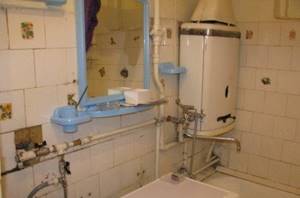
Standard geyser
Now let's touch on electrical appliances.
Electric boilers
There are many electric boilers on sale today that are capable of heating even very large areas.
However, how effectively they can do this and at what cost is a big question.
Probably, boilers of this type are worth buying when there is no alternative - that is, gas. Or as a backup option - in case the main gas boiler suddenly breaks down in the middle of winter.
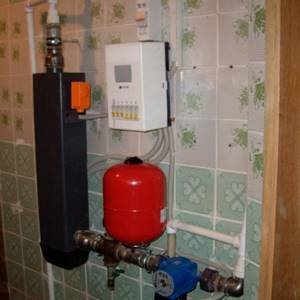
Electric boiler
Why this particular recommendation?
- Firstly, because whatever one may say, such a device “eats” a lot of electricity - and this, accordingly, will significantly hit your pocket.
- Secondly, even very expensive electric boilers, as a rule, have a rather low level of efficiency - in practice, this means that during severe cold weather, if the house is not well insulated, it will be very difficult for the boiler to quickly warm up all the water in the system. A gas boiler is much better in this regard - since it will reheat the cold water coming from the system in a matter of seconds.
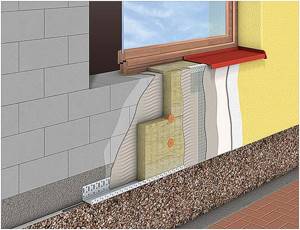
Insulation scheme for the facade of a country house
No, of course, electric boilers also have a right to life, but if we are talking about large heating areas, then it is important to understand several points:
- The house must be well insulated.
- Heating with electricity is more expensive than gas - so if the situation is, as they say, “without options,” then maybe it’s worth trying to get some kind of subsidies or discounts on electricity.
- If there is no gas in the house, and suddenly the electricity is turned off, what to do, how to heat the house? Perhaps it makes sense to purchase a combination boiler that can run on solid or liquid fuel.
And of course, electric boilers have an undoubted big advantage - unlike gas appliances, you can easily connect them yourself, without any permits.
Note! Connecting an electric boiler is a simple matter, but just be sure to make sure that the wiring, circuit breakers and meter can withstand the load. Because if all this is old and bad, then there will be constant malfunctions in the operation of the boiler. And in this case, trouble is not far away.
As for what is needed for hot water supply and heating at the same time, there are not many options. Water for domestic needs will be heated either by the second circuit of the boiler (if available), or you will have to additionally purchase and connect a boiler or instantaneous electric heater.
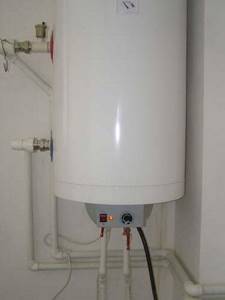
Electric boiler
Now let's look at an equally important point - what radiators are on the market and what is best to buy. And then we’ll figure out the principles of installing the entire system as a whole.
Which radiators to choose
There can be no universal recommendation here! Because you need to choose one or another type of radiator based on the capabilities of a specific budget, the area and volume of the premises, the number and size of windows, as well as the type of boiler. And, of course, it is important to focus on the surrounding design, the concept of the environment.
Therefore, just take note of the characteristics of each type of radiator and make a decision based on the characteristics of your specific situation.
Radiators are like this:
- Aluminum heating radiators. As a rule, these are cast products that are lightweight, relatively low cost and have a high heating rate. The disadvantages include the not very chic appearance, as well as the rapid cooling of the water in the system;
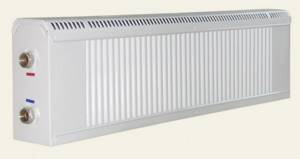
Aluminum radiator
- Bimetallic heating radiators. These devices are very resistant to hard water and are more suitable for central heating systems. But of course, bimetal can also be used to heat a private home - the design of such batteries is, in principle, not bad, but the price in this case is also rather high. Another feature of these products is the ability to add or reduce the number of sections;

Bimetallic radiators
- Steel radiators. These are efficient heating devices, quite beautiful, durable and “average” in price. They heat up quickly, but cool down just as quickly. The main advantage is that to heat such a radiator you need a very small amount of water - and this directly saves gas or electricity;

Steel radiators
- Cast iron batteries. The main advantages are durability, interesting design, slow cooling of the metal and resistance to corrosion. The disadvantages include the heavy weight and rather high cost of the products.
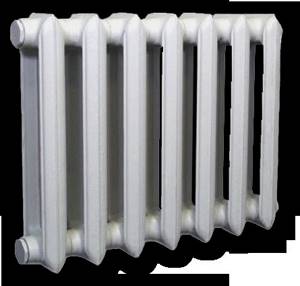
Cast iron radiators
So what should you choose?
Probably due to the large amount of water in bimetallic, aluminum and cast iron products, they are unlikely to be suitable for an electric boiler that heats a large area. In this case, the optimal solution would be to purchase steel radiators.
And for gas boilers, in terms of efficiency, in principle, any of the listed radiators are suitable.
But of course, if you buy a product made of metal that cools quickly, remember that in this case it is highly desirable to insulate the house well. Otherwise, the consumption of gas or electricity will be high.
Now let's look at how to assemble a system for hot water supply and heating - what is important to pay attention to and what is needed to carry out the work.
Selection by power and methods of connecting radiators
The number of sections or the size of a panel radiator is selected based on the amount of heat required to heat the room. We have already determined this value at the very beginning; it remains to reveal a couple of nuances. The fact is that the manufacturer indicates the heat transfer of the section for a temperature difference between the coolant and the air in the room equal to 70 °C. To do this, the water in the battery must warm up to at least 90 ° C, which happens very rarely.
It turns out that the real thermal power of the device will be significantly lower than that indicated in the passport, because usually the temperature in the boiler is maintained at 60-70 ° C on the coldest days. Accordingly, for proper heating of the premises, the installation of radiators with at least one and a half heat transfer margin is required. For example, when a room needs 2 kW of heat, you must take heating devices with a capacity of at least 2 x 1.5 = 3 kW.
Indoors, batteries are placed in places of greatest heat loss - under windows or near blank external walls. In this case, connection to highways can be done in several ways:
- lateral one-sided;
- diagonal scalene;
- lower - if the radiator has appropriate pipes.
The lateral connection of the device on one side is most often used when connecting it to risers, and the diagonal connection to horizontally laid highways. These 2 methods allow you to effectively use the entire surface of the battery, which will heat evenly.
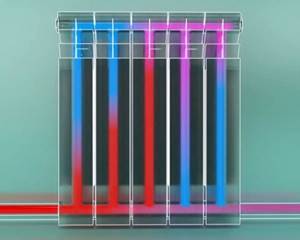
When a single-pipe heating system is installed, the lower versatile connection is also used. But then the efficiency of the device decreases, and hence the heat transfer. The difference in surface heating is illustrated in the figure:
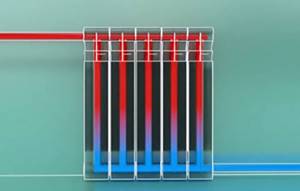
There are models of radiators where the design provides for connection of pipes from below. Such devices have internal wiring and, in fact, they have a one-sided side circuit. This can be clearly seen in the figure, where the battery is shown in section.
A lot of useful information on the issue of choosing heating devices can be found by watching the video:
Selecting a heating boiler
Heating boilers can be different in configuration and type of fuel used. Gas-fired heating boilers are most often used, so further we will talk about boilers of this type.
An approximate calculation of the boiler power is performed using the formula: for heating 10 sq.m. The premises require a thermal power of 1 kW. This formula is valid for a well-insulated house and a ceiling height in the room of approximately 2.7 m.
For the convenience of choosing a gas heating boiler, it is convenient to divide the entire range into two categories according to the type of combustion chamber and the number of circuits.
Gas heating boilers can have an open or closed combustion chamber. An open combustion chamber means that the boiler uses air from the room to operate, and the exhaust gases are removed naturally through the chimney. Boilers with a closed combustion chamber are supplied with air through a built-in fan through a coaxial chimney, and combustion products are removed through it.

Fig.9.
Diagram of boilers with an open and closed combustion chamber.
boilers with an open combustion chamber in a separate room (boiler room) with good ventilation. Also for this type of boiler it is necessary to install a chimney, which should rise above the ridge of the roof of the house. Typically this category includes powerful floor-standing boilers designed for heating large areas.
Boilers with a closed combustion chamber can be installed anywhere in the house; they are often installed in the kitchen. For boilers of this type, a coaxial chimney is used, which is vented to the street through the wall of the house where the boiler is installed.

Fig. 10.
An example of installing a boiler with a closed combustion chamber and a coaxial chimney.
A heating boiler can work not only to heat the coolant, but also to provide the house with hot water. For a small house it is convenient to use a boiler with two circuits, the so-called double-circuit boiler. In boilers of this type, one circuit provides heating and the other provides hot water supply.

Fig. 11.
Installation diagram of a two-control boiler in a heating and hot water supply system.
If more than 3 people live in a house and the hot water supply is large, then a double-circuit boiler is unlikely to cope with the task. In this case, an indirect heating boiler is used to organize hot water supply.

Fig. 12.
Diagram of a heating system with an indirect heating boiler (indicated by number 31 in the figure).
An indirect heating boiler is a sealed barrel with an internal heat exchanger through which water from the heating system circulates and thereby heats water for the water supply system.
Choosing a coolant
It is well known that filtered and, if possible, desalted water is most often used for this purpose. But under certain conditions, for example, periodic heating, water can freeze and destroy the system. Then the latter is filled with a non-freezing liquid - antifreeze. But you should take into account the properties of this liquid and do not forget to remove all regular rubber gaskets from the system. Antifreeze quickly causes them to become limp and leaks occur.
Attention! Not every boiler can work with non-freezing liquid, which is shown in its technical data sheet. This must be checked when purchasing it.
As a rule, the system is filled with coolant directly from the water supply through a make-up valve and a check valve. During the filling process, air is removed from it through automatic air vents and manual Mayevsky taps. In a closed circuit, pressure is monitored using a pressure gauge. Usually when cold it is in the range of 1.2-1.5 Bar, and during operation it does not exceed 3 Bar. In an open circuit, it is necessary to monitor the water level in the tank and turn off the replenishment when it flows out of the overflow pipe.
Antifreeze is pumped into a closed heating system using a special manual or automatic pump equipped with a pressure gauge. To ensure that the process is not interrupted, the liquid must be prepared in advance in a container of appropriate capacity, from where it must be pumped into the pipeline network. Filling an open system is easier: antifreeze can simply be poured or pumped into the expansion tank.

